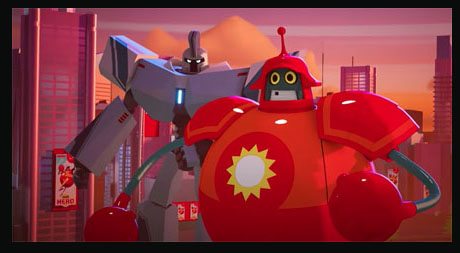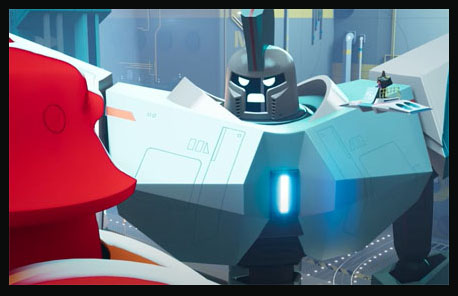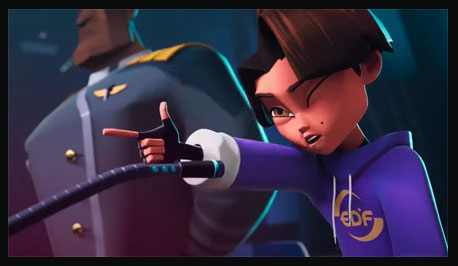
Academy Award winner Mark Andrews (director of Pixar’s Brave) is now the director and EP of new, innovative Netflix animated series Super Giant Robot Brothers. Andrews describes how using video game technology, motion capture and real-time techniques help make this show (premiering tomorrow, Thursday August 4th) come to life. (This Animation Scoop Q&A was edited for length and clarity.)
Jackson Murphy: I’ve seen the first couple episodes, and I have to tell you, it has such a great, cinematic feel to it. How did you want to bring a cinematic feel to this series?
Mark Andrews: I’ve done storyboards my entire life, and that’s basically drawing cinematography. And then I had a fantastic DP on the show, Enrico Targetti, who’s a live-action cinematographer and also an Unreal [Engine] expert. We hit it off. It’s such a dynamic show. And it’s an action show with giant robots. You CANNOT do this with bland cinematography. We wanted to really pump up the volume on this and do stuff that you don’t normally see in animation. So that’s what you get.

JM: Yeah. And it feels like every kid’s dream to see this come to life. Could you really feel that as you were making this?
MA: Absolutely. I grew-up on all these old Japanese animated shows [like] Giant Robo and Johnny Sokko… which were fantastic. It’s definitely within my wheelhouse, being a sci-fi animation manga / anime nerd.
JM: And kids playing with robot toys and moving them around!
MA: I’m waiting for my toys! Where’s my Shiny and Thunder? I want all the stuff. And I want all the kaiju sitting on my shelves.
JM: They battle it out. Shiny and Thunder are such well-defined characters right out of the gate. How did you want to present them?
MA: You have this sibling rivalry. And in the show the oldest brother, Shiny, who was the first robot created by a three-year-old… that’s why he looks like a lollipop, right? He’s also three years old. The whole arc of the show is him growing up. When you have a character that’s going through such a transformative stage, that already has great potential. Then his younger brother, who happens to be more mature and made by the same character, Alex, but she was 13/14… this is a badass teenager who’s a professional. You have this logic and this unchecked emotion battling it out against each other, and who’s the head robot? That leads into a lot of great character development throughout each episode.

JM: We see Alex as [a teenager], but also as a three year old. She’s gotta be the smartest animated character ever created.
MA: (laughs) She is. She’s the smartest person on the planet. She comes from very smart parents, who get sucked into this black hole space anomaly and disappear. Now it’s all up to her. She’s this workaholic. You take someone who’s the smartest person in the world and put them inside a teenage body — that is a volatile, volatile mix. Somebody who’s incredibly self-aware and is smarter than anybody in the world. There’s a little missing childhood in her in this show, and she’s essentially a single parent. And I love that aspect of Alex. You have this dysfunctional family, but we’re really watching a single mom trying to raise these two robots that are fighting all the time.
JM: And then you’ve got all the crazy action and antics.
MA: My bread and butter.
JM: (laughs) I watched a behind the scenes video of the making of this show, which you were a part of, which is fascinating. You are using motion capture and real-time technology. It’s unbelievable.
MA: With the advent of game engines becoming more and more powerful, what that gives creators is a tool to, actually in animation, work in context for the first time. Traditional animation pipelines, from 2D to 3D, you’re working out of context. Everything is developed in a separate bucket, and then it’s all brought together at the end and you get what you get. But at that point changing things or even the aspect of discovering kind of goes away. Being in this Unreal Engine: we go onto a motion capture stage. I have my actors. They can be anything from a kaiju to a robot to a 14 year old girl and everything in between. And we can motion capture everything: jets, cars, bugs, laser beams.
As a creator and storyteller I am working within context. I see it on the stage. I see it in the monitor and I can also have the virtual cameras. I can be anywhere at any time. If I want my helicopter shot, I don’t have to rent a helicopter. I am the helicopter shot. I can also slow down time in this tool so I can slow-motion stuff. Or filming something that’s complex, like rolling around a punch until it hits a kaiju’s face. I can slow down that footage and actually roll myself around that punch to get some super dynamic cinematography. The Unreal Engine, this whole virtual production pipeline, allows me this great freedom — this iterative power — of working within context.

JM: Wow. Dynamic is the perfect word. And there are so many cool shots. There are the helicopter shots. Episode two has some training for the characters. They’re in this arena and it’s so slick. It’s so cool. I bet all those movements really come in handy for a sequence like that.
MA: They absolutely do because we’re chasing potential. You have these giant robots in this training room. They’re 200 feet tall, so this training room is thousands of feet wide and tall. They’re moving really fast. They’re not clunky robots. It’s really fun to play with that. You have all the tools at your disposal a lot faster in the process. I’m not waiting ’til the end to see it. I can plan and create stuff and even improvise in the moments, and that was one of the scenes where we improvised. What does Shiny exactly do running on this parkour course for a robot? We can have fun trying stuff out, and that’s something you don’t have in animation. I get to shoot coverage, like in live-action.
It takes three days to capture an episode on a stage and then another four to five days to actually shoot it with a camera. But once that’s done, I’m walking away with 12 hours of footage for a 22-minute episode. So we have A LOT of stuff to cut. The editorial process on this was super energizing because my editors now have more footage than they can ever possibly imagine in a traditional sense. They had fun cutting stuff together — we could find that energy a lot easier than we can in a traditional point of view, or using a traditional pipeline.
JM: This is one of the most ambitious animated series I’ve ever learned about. You have so much to keep track of, along with comedy — punchlines and delivering jokes. Where does that rank among everything you have to keep track of?
MA: It’s a lot. You’re juggling a lot. But the fun thing about being in context is that I don’t have to worry about a lot of it. We set them up from the script. I get on the stage with my actors and we do the pages but I can see immediately if it’s really working or not. And I can try new things. So you have this almost workshop improv on the stage that you never get in animation. And actors being actors, they’re gonna try stuff too. Giving them permission to play around. We found A LOT of material. A good 50% of the material came out of our banter and improv on the stage, and suddenly I’m like, “This is the scene! Not that thing we just did that we wrote! This is now the scene!” Or this is the gag that will dominate the scene and we just chase that down the rabbit hole, which usually gives us gold. We don’t have spontaneity in animation. Now we have it. I’m a reactive director, so I see it and I react to it. I can say, “This is it” until we hear something better. You just open up and go with it.

JM: I recently spoke with Steve Purcell, the co-director of Brave, for its 10th Anniversary.
MA: My buddy.
JM: Anything you learned while working on Brave that you applied to Super Giant Robot Brothers?
MA: Absolutely. Brave was a fantastic experience. All the new things on that we were trying in animation, even from a cinematography point of view where we had this much more dramatic theatrical lighting. Moving away from the pastels and into this dark stage kind of lighting. This is a progression of that. Once I got in here with these tools — how can I push the tools to their limits? I feel that in animation we always want to push. Pixar is fantastic. They’re creating tools. We can push up to the edge of the envelope. But now with the game engines, and Unreal Engine specifically, I’ve got so many more tools I can push in so many more different areas. I had fun finding where those breaking points were. That’s where you get into discovery. Discovery makes everything much more exciting and organic at the end of the day.
JM: How would you honestly react if there were giant robots and kaiju that appeared on the Earth?
MA: If it was Shiny and Thunder, I know by the end of the day they’d defeat the kaiju and it’d be pretty fun to watch. I don’t think I’d be that worried. But if it was ACTUAL REALITY, I think everybody would be crapping their britches. (laughs)
JM: (laughs) And then they’d go to you. You’d be the source; the go-to guy. You’d be on the news all the time. You do a lot with the media, especially in the second episode. You’d be interviewed as the expert in all this.
MA: That’s right. “As the super giant robot kaiju expert, Mark Andrews here on Channel 18 Million.” Yes. (laughs)
JM: How do you hope that what you’re doing with this show is gonna change the way we look at animation — and how we use animation for a television format.
MA: Animation has always had this stigma of just being for children because of the type of characters and type of stories that were told, and frankly just the way it looked. But as these technologies get faster, they can give the storyteller filmmakers… we now longer have those stigmas or limitations. This is shot like any Michael Bay movie.
JM: Yes!
MA: And even beyond. Animation then just becomes another medium that can be for everybody. It’s just as sophisticated. It’s just as complex, while retaining a simple kind of graphic animation look to let the audience in and just be kind of accepting of the tone and the world this story — or any type of animation story — is. It’s not live-action, so I can let go a little bit more. I have a little bit more willing suspension of disbelief in animation, and therefore the stories can get into me better and let it be more effective.
- INTERVIEW: Jeff Fowler On “Knuckles” And “Sonic 3” - April 22, 2024
- INTERVIEW: “Inside Out 2” Director And Producer On Pixar Sequel - April 16, 2024
- INTERVIEW: “Puffin Rock And The New Friends” And 25 Years Of Cartoon Saloon - April 10, 2024


 August 3rd, 2022
August 3rd, 2022  Jackson Murphy
Jackson Murphy  Posted in
Posted in  Tags:
Tags: 






